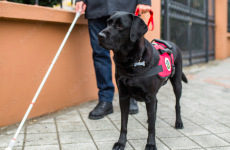
By: SherryJo Crandall
Word on the Street Issue 45, July 2024
. . .
This author has a clear and defined bone of contention with people who claim their dog is a service animal when it is clearly evident that their dog does not meet the criteria set forth by the Americans with Disabilities Act, The Fair Housing Act plus local laws.
The ADA clearly states that a dog and miniature horse are the only recognized service animals. It goes on to define a service animal as being trained to perform tasks related to an individual’s disability. It further states that a service animal is not a pet.
This where the line between assistive animals and service animals has been blurred by the public. To help the reader understand the difference, I will use my situation as an example. I was diagnosed with Degenerative Disk Disease in my back due to deformed vertebrae. Eventually I also developed Arthritis which can cause me to be wheelchair bound. Because of being homeless, I was diagnosed with PTSD and Anxiety.
Because of my PTSD and Anxiety, I was able to get a cat. She is an assistive animal. She is not a horse or dog but the not so clear point is she doesn’t do specific tasks related to my disability.
My disability is defined by the ADA and The Fair Housing Act as the following:
1. A physical or mental impairment which significantly limits a person’s major life activities.
2. Major life activities include but are not limited to taking care of oneself, performing manual tasks, sleeping, eating, bending. It also includes bodily functions such as cell growth, circulatory, neurological but is not limited to these.
Eventually, when I move out of the place I currently reside in, I will be getting a service dog that will be trained to perform tasks related to my disability. Tasks will include pulling me up from chairs, diabetes alerting and to help me should I fall.
Training through a certified trainer or a certified program is not required by the ADA or The Fair Housing Act but the ADA gives the disabled reason to make sure their dogs have basic obedience training. By law businesses and other entities are only allowed to ask if your dog is a service animal and what tasks do they perform but at the same time if the dog is unruly and the handler refuses to control the animal or the animal is not housebroken, they the service dog can be asked to leave a place.
Now that we have the basics down, let’s talk about how theADA affects housing. The ADA establishes building requirements geared to make housing accessible. That, however, does not apply to service animals. In the case of service dogs and emergency shelters, service dogs fall under the fair housing act. While a shelter cannot deny a disabled person access to their service animal under the ADA, a shelter is also required to make reasonable accommodations for the disabled person and their service animal. No matter what, the ADA stipulations:
1.the dog must be under the control of the handler at all times and
2. the dog must be housebroken.
These are the only ways a shelter can remove a service animal from their facility. I don’t have much more to say on this part but I do know some people who camp out, so they can keep their dogs with them. They often put their animals above themselves. Providing them with access to basic obedience training may be a way to get them housed. The training and being reassured that their dogs will stay with them will go a long way to stabilize their mental health and get them into housing.
There are many reasons people refuse to accommodate a service animal. The biggest reason is ignorance of the laws governing service animals. Until 2010 resulted in changes to what a service animal was, there was a lot of abuse of the ADA. Most of that was due to lack of clarity in the definition of an assistive animal and a service animal. An assistive animal will not perform a task related to a disability, such as guiding you if blind. An assistive animal provides comfort when a person needs it whereas a service animal has tasks that it performs.
In the homeless community, we see a lot of assistive animals. That’s not surprising given how big of an issue mental health is.
This is also a clear example of what I am talking about. The dogs are not trained in basic obedience. They are not under the control of their handler. I don’t know if offering basic obedience would help but I do know that shelters and housing entities need to take this issue more seriously.
